
(Source. Collection Weisman Art Museum. Photo: Rik Sferra.)
“Natural History of the Enigma” is a series of works that presents the transgenic petunia flower “Edunia”, which has part of the artist Eduardo Kac’s genetic sequence inserted into it. Aside from the plant itself, the series comprises of limited edition seed packs of the plant, a set of lithographs called “Edunia Seed Pack Studies”, the public sculpture “Singularis”, watercolor paintings “Mysterium Magnum I-VIII”, and photographs of the plant “Plantimal I-VI”. The project was developed by Eduardo Kac in collaboration with scientists from University of Minnesota between 2003 and 2008, and was initially exhibited at the Weisman Art Museum in Minneapolis [1].
The “Edunia” is originally a petunia, a type of annual flowering plant, has been genetically engineered to carry a portion of Kac’s gene that encodes an antibody, and express it in the flower’s veins. The DNA sequence was obtained from part of Kac’s antibody called IgG, inserted into a bacteria, which acts as a vehicle to deliver the gene into the plant. The gene is inserted in such a way that it is present in all cells of the plant, but it is pre-pended with a flag so that it is only expressed in the veins of the plant. Additionally, the gene is appended with a plant protein, which can be used to detect the expression of the artist’s gene.

(Source)
The petunia flower was chosen so that its pink color is reminiscent of the human blood vessels. And the gene was chosen because of its function as part of an antibody, which recognizes foreign substances that invades the body. The artist’s intention was to have “precisely that which identifies and rejects the other [that I] integrate into the other, thus creating a new kind of self that is partially flower and partially human.” In doing so, he reflects on the relatedness of all life, and “bring forth the reality of the contiguity of life between different species” [1].
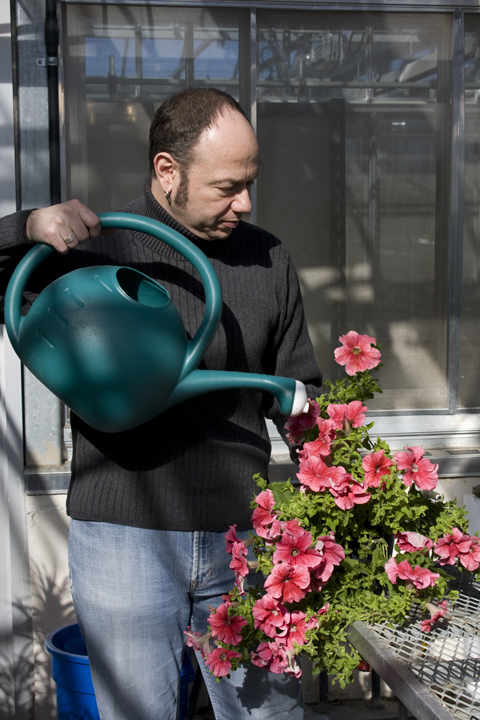
(Kac watering Edunia. Source)
Continuing on his theme about life, Kac notes that compared to other creatures such as dogs, cats, or apes, which can communicate directly with people, plants have much greater difficulty in evoking the same level of connection. This is even when a great many analogies between “anthropomorphic and botanical forms” can be formed in the studies of philosophers and scientists. Therefore, in forming Edunia, Kac wishes to “instill in the public a sense of wonder about this most amazing of phenomena we call ‘life'”. [1]
(Kac holding an Edunia. Source)
To accompany Edunia, Kac have produced the following works:
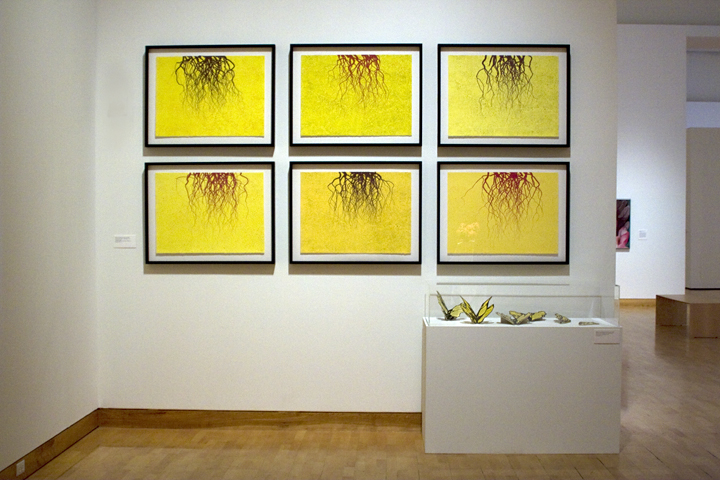
(Lithographs of “Edunia Seed Pack Studies”. Collection Weisman Art Museum, Minneapolis. Source)
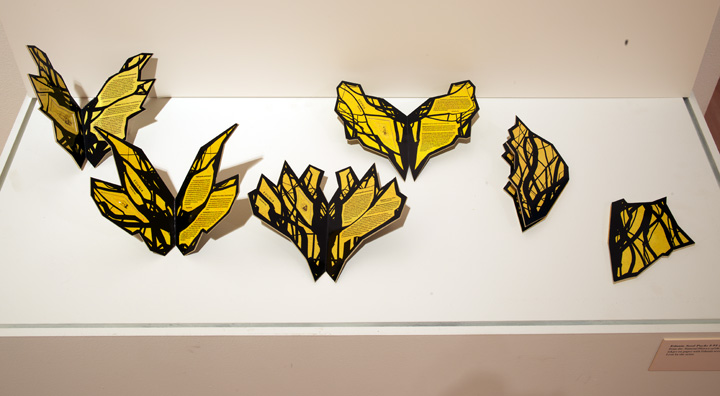
(Six limited edition Edunia Seed Packs. Each is made with paper and held closed with magnets. These are hand-made by Kac, and contain description on how to cultivate the flower. Source)
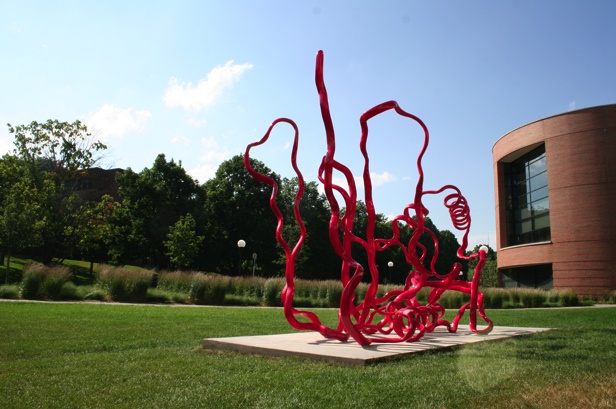
(The metal and fiberglass sculpture “Singularis” in St. Paul, Minnesota. It is a composite structure of a human protein and a plant protein [1]. Source)
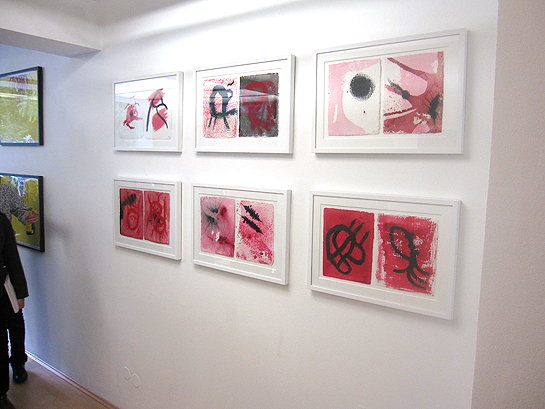
(A series of watercolor paintings “Mysterium Magnum I-VIII”. Collection Margit Eigl, Linz, Austria. The paintings explore the link between life and communication, the “watercolors oscillate between evoking biomorphic patterns and sign systems” [1]. Source)
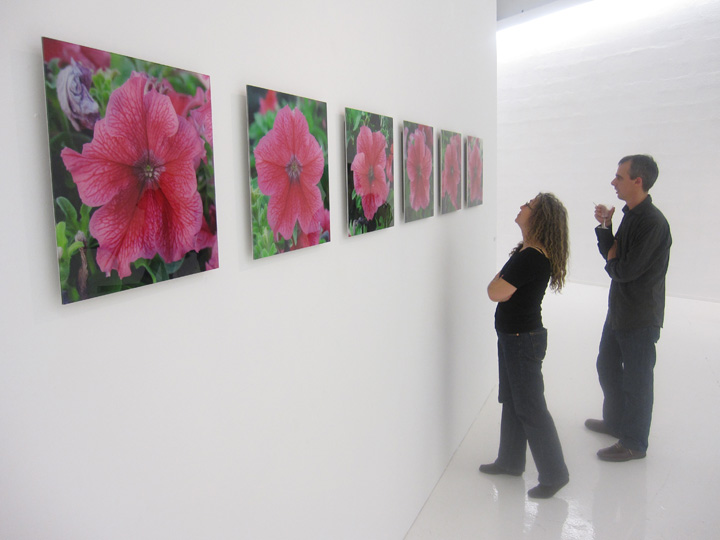
(The photographs “Plantimal I-VI”, which are pictures of clones of Edunia. Despite of that, the difference between the flowers highlight the fundamental fact: “All life is singular” [1]. Source)
In light of the explosion of biotechnology in recent years, Kac’s works are particularly relevant. A Brazillian-born artist, he is known for his cutting-edge works in telepresence and bio art, and was the recipient of the Golden Nica Award in 2009 [2]. His interest lies in “the philosophical and political dimensions of communication processes”, which manifests in the tendency of his work to “encourage[s] dialogical interaction and confronts complex issues concerning identity, agency, responsibility, and the very possibility of communication” [2]. In particular, two of his works points in roughly the same conceptual direction as “Natural History of Enigma”, namely: Genesis (1999) and Alba (2000), which is also known as “GFP bunny”.
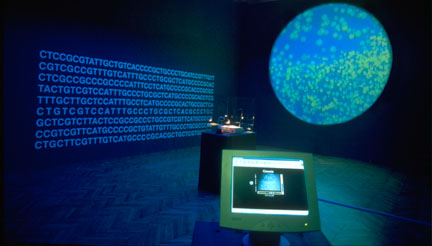
(Genesis. Collection Instituto Valenciano de Arte Moderno (IVAM), Valencia, Spain. Source)
In “Genesis”, a verse in the Bible is translated into a DNA sequence, which is then inserted into a bacteria and displayed in a gallery. Viewers of the work are given the ability to shine ultraviolet light upon the bacteria, which increases the rate at which the bacteria mutate, and thus changing the encoded phrase when it is translated back into English. In the description of this project in Art and Electronic Media, Edward Shanken points out that “Genesis raises questions about the shared responsibility of individuals to care for other living beings – in this case, to control environmental factors that are known to cause genetic mutations” [3].

(Alba. Source)
In “Alba”, the green fluorescent protein, originally found in jellyfish, is inserted into an albino rabbit, which causes the rabbit to emit a green glow when placed under UW light. In this piece, the work of art is not only the rabbit itself, but encompasses the whole process of how the rabbit is created, the conversation surrounding it, and the reaction which it generates in the viewer. In his essay “GFP Bunny”, Eduardo Kac says that “what is important is the completely integrated process of creating the bunny, bringing her to society at large, and providing her with a loving, caring, and nurturing environment… it places genetic engineering in a social context in which the relationship between the private and the public spheres are negotiated” [4].
In speaking of his works, which may be called “transgenic art”, Kac emphasized that “[T]ransgenic art…offers a concept of aesthetics that emphasizes the social rather than the formal aspects of life and biodiversity, that challenges notions of genetic purity, that incorporates precise work at the genomic level, and that reveals the fluidity of the concept of species in an ever increasingly transgenic social context” [4]. At times when the biotechnology field’s capacity to manipulate and control living organisms is advancing at an incredulous pace, it is necessary that society engage in a conversation about what is acceptable, and what ought to be acceptable. The conception of species, the sanctity of living things, and even the notion of human as steward over other species, are all based upon a belief system of time past. Regardless of whether these ideas are true or not, one must at the very least consider the position of such ideas in the contemporary social context. Society changes, and norms of a previous times may be completely and wildly inapplicable in the present time. When the change that is and will be coming concerns the nature of life, the questions are profound ones. As in “Genesis”, if one has control over other species, what should one do? As in “Alba”, a transgenic organism is a living organism, with all its associated physical and emotional belonging, what ought we to do with it? And as in “Natural History of Enigma”, if another species can take on some properties of a human, then where does human stand in this?
The conversations initiated by these works may be regarded as revolving about philosophical and ethical questions, but they are also nevertheless conversations about social and cultural values. When Marcel.lí Antúnez Roca allowed the audience to control his body in Epizoo (1995), or when Stelarc grafts onto himself a robotic arm in Third Hand (1981), it is about fundamentally the same question as Edunia: what are we, as a society, to do when technology transcends the pre-existing ego, body, and species.
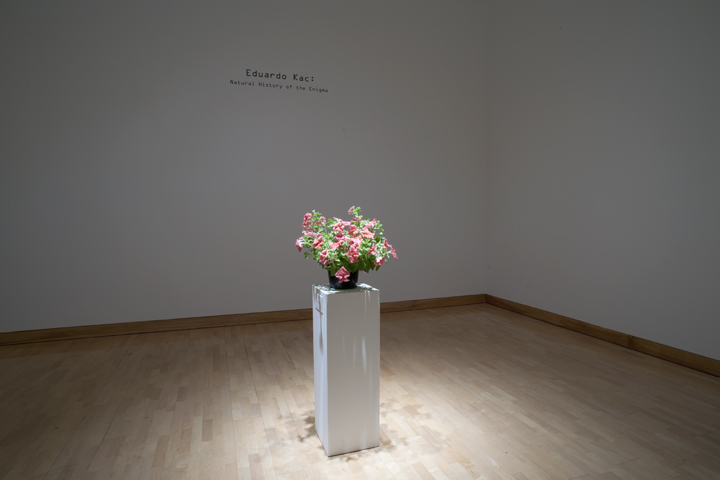
Weisman Art Museum, Minneapolis, April 17 to June 21, 2009.
[1] Eduardo Kac. “Natural History of the Enigma”.
[2] KAC BIO – 600 words.
[3] Edward Shaken. Art and Electronic Media. Page 42
[4] Eduardo Kac. GFP Bunny.
